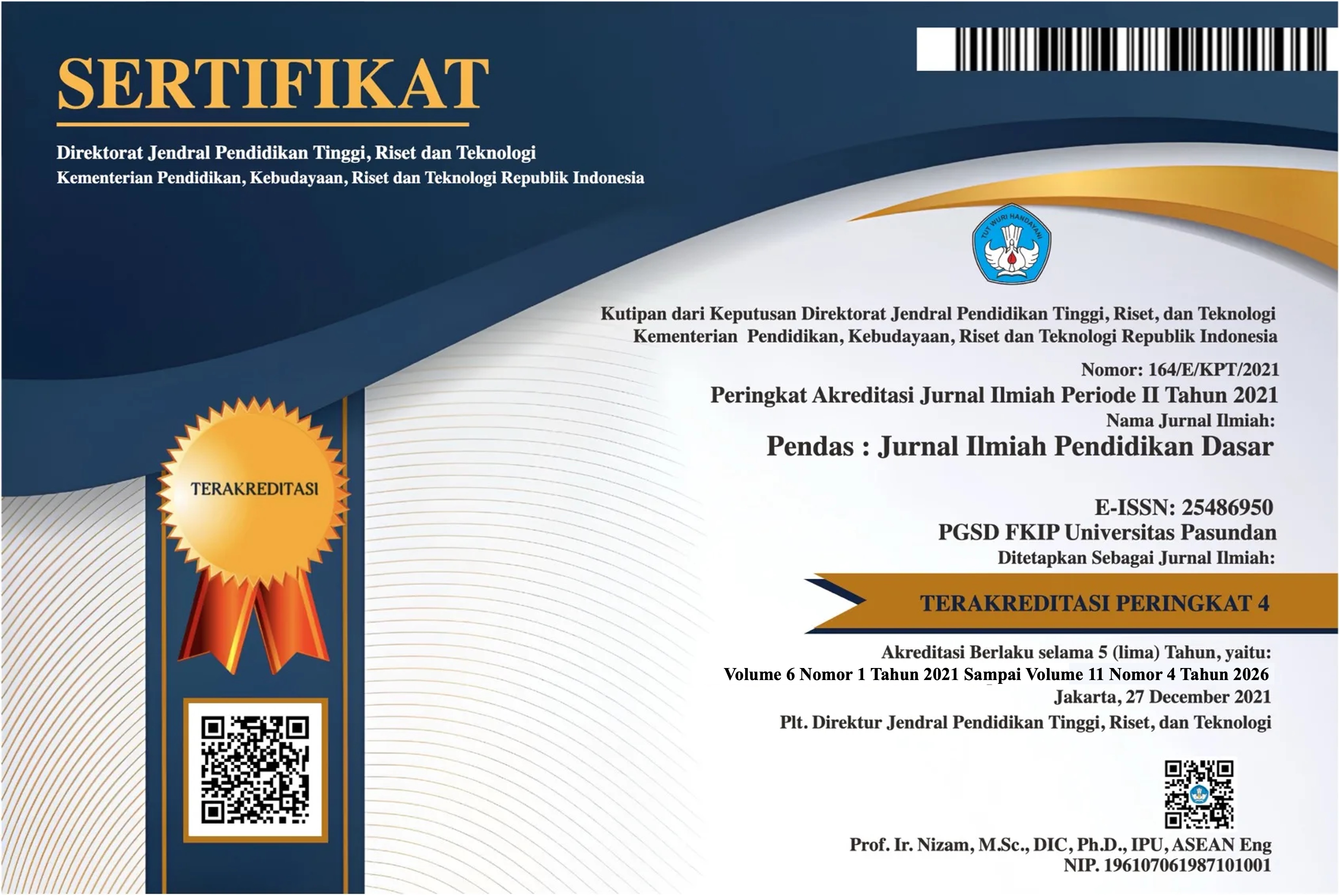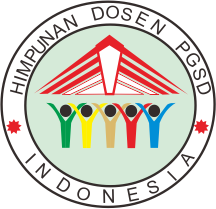EFEKTIVITAS PSIKOEDUKASI MORAL ENGAGEMENT DI SMA MUHAMMADIYAH 3 TULANGAN DALAM MENURUNKAN BULLYING PADA SISWA
DOI:
https://doi.org/10.23969/jp.v9i04.21899Keywords:
Psychoeducation, Morals, and BullyingAbstract
This research aims to measure the effect of moral engagement psychoeducation on reducing bullying behavior among students at SMA Muhammadiyah 3 Tulangan. The research method used was quantitative experimentation with a student population of 35 people. The sampling technique used is saturated sampling. The scale used to measure bullying behavior is a pre-test and post-test scale compiled by researchers, while to measure moral engagement the Comprehensive School Climate Inventory (CSCI) is used. The analysis technique used is paired sample t-test using JASP software version 0.18. The research results showed that there was a significant difference between the pre-test and post-test results after being given moral engagement psychoeducation (t(34) = -5.619; p < 0.001). These results prove that moral engagement psychoeducation can reduce bullying behavior in students and increase moral engagement in the school environment.
Downloads
References
Aisyah, R. N., Asri, D. N., & Dewi, N. K. (2023). Analisis Moral Disengagement Siswa SMKN 2 Kota Madiun. Seminar Nasional Sosial Sains, Pendidikan, Humaniora (SENASSDRA), 2(2), 309–315. http://prosiding.unipma.ac.id/index.php/SENASSDRA
Al Umairi, M. (2023c). Kreativitas Guru Dalam Mengajar Anak Usia Dini Di Taman Kanak-kanak TK At-Taufiq Surabaya. Jurnal Pendidikan Islam Anak Usia Dini Al-Amin, 1(1), 82–96. https://ejournal.staialamin.ac.id/index.php/piaud/article/view/40
Al Umairi, M. (2023b). Development of Social Interaction and Behavior for Early Childhood Education in the Era Society (5.0). JOYCED: Journal of Early Childhood Education, 3(2), 167–176. https://doi.org/10.14421/joyced.2023.32-08
Amanda, V., Wulandari, S., Wulandari, S., Nabila Syah, S., Andi Restari, Y., Atikah, S., Engkizar, E., Anwar, F., & Arifin, Z. (2020). Bentuk dan Dampak Perilaku Bullying terhadap Peserta Didik. Jurnal Kepemimpinan Dan Pengurusan Sekolah, 5(1), 19–32. https://doi.org/10.34125/kp.v5i1.454
Aprilia Ramadhani, & Sofia Retnowati. (2013). Depresi Pada Remaja Korban Bullying. Jurnal Psikologi UIN Sultan Syarif Kasim Riau, 9(Desember), 73–79.
Bjärehed, M., Sjögren, B., Thornberg, R., Gini, G., & Pozzoli, T. (2024). A short-term longitudinal study on the development of moral disengagement among schoolchildren: the role of collective moral disengagement, authoritative teaching, and student-teacher relationship quality. Frontiers in Psychology, 15. https://doi.org/10.3389/fpsyg.2024.1381015
Bussey, K., Luo, A., & Jackson, E. (2024). The role of moral disengagement in youth bullying behaviour. International Journal of Psychology : Journal International de Psychologie, 59. https://doi.org/10.1002/ijop.13254
Celniker, J. B., Ringel, M. M., Nelson, K., & Ditto, P. H. (2022). Correlates of “Coddling”: Cognitive distortions predict safetyism-inspired beliefs, belief that words can harm, and trigger warning endorsement in college students. Personality and Individual Differences, 185, 111243. https://doi.org/https://doi.org/10.1016/j.paid.2021.111243
Chaidar, M., & Latifah, R. A. (2024). Faktor - Faktor Psikologis Penyebab Perilaku Bullying. Blantika: Multidisciplinary Jornal, 2(6), 657–667. https://blantika.publikasiku.id/index.php/bl/article/view/166/275
Cuadrado-Gordillo, I., Fernández-Antelo, I., & Parra, G. M. M. (2020). Moral disengagement as a moderating factor in the relationship between the perception of dating violence and victimization. International Journal of Environmental Research and Public Health, 17(14), 1–14. https://doi.org/10.3390/ijerph17145164
Dan, P., Ari, S. A.-Z., & Pekawinan, A. (2011). Bab Iiﻋ. 9(2003), 22–52.
Denisa, A., Amalia, D. R., Faiqoh, E., & Umairi, M. Al. (2024). Pola Komunikasi Keluarga Untuk Mengembangkan Sosial Emosional Anak Usia Dini Di Desa Bungah Gersik. 2(2), 73–79. https://doi.org/https://doi.org/10.28926/bocil.v2i2.1552
Devereux, P. G., Miller, M. K., & Kirshenbaum, J. M. (2021). Moral disengagement, locus of control, and belief in a just world: Individual differences relate to adherence to COVID-19 guidelines. Personality and Individual Differences, 182, 111069. https://doi.org/https://doi.org/10.1016/j.paid.2021.111069
Empati, J., Hanitis, P. M., & Setyawan, I. (2015). Hubungan Antara Persepsi Terhadap Iklim Sekolah Dengan Intensi Bullying Pada Siswa Sd Islam X. Empati, 4(1), 134–141.
Gini, G., Thornberg, R., & Pozzoli, T. (2020). Individual moral disengagement and bystander behavior in bullying: The role of moral distress and collective moral disengagement. Psychology of Violence, 10(1), 38–47. https://doi.org/10.1037/vio0000223
Guo, Q., Guo, Y., Qiao, X., Leng, J., & Lv, Y. (2021). Chance locus of control predicts moral disengagement which decreases well-being. Personality and Individual Differences, 171, 110489. https://doi.org/https://doi.org/10.1016/j.paid.2020.110489
Hasibuan, N. S., Salmiyati, S., Lestari, Y. I., & Mukhlis, M. (2023). Moral Disengagement and Cyberbullying among Adolescent Social Media Users: Do Gender Differences Exist? Indonesian Psychological Research, 5(2), 70–77. https://doi.org/10.29080/ipr.v5i2.953
Kuasandra, M. K., & Japar, M. (2020). The Effect of Moral Disengagement on Bullying Behavior Tendency with Empathy as a Mediator on Students in Pekalongan City. Jurnal Bimbingan Konseling, 9(2), 103–110. https://journal.unnes.ac.id/sju/index.php/jubk
Liu, D., Liu, X., & Wu, S. (2022). A Literature Review of Diffusion of Responsibility Phenomenon.
Liu, J., Han, Z., Ma, X., & Xin, R. (2023). Moral disengagement and cyberbullying perpetration among adolescents: The moderating role of empathy. Children and Youth Services Review, 155, 107178. https://doi.org/https://doi.org/10.1016/j.childyouth.2023.107178
Mewar, M. R. A. (2021). Krisis Moralitas Pada Remaja Di Tengah Pandemi Covid-19. Perspektif, 1(2), 132–142. https://doi.org/10.53947/perspekt.v1i2.47
Morera, M. D., Quiles, M. N., & Gonzalez-Mendez, R. (2020). Integrating Dehumanization and Attachment in the Prediction of Teen Dating Violence Perpetration. Journal of Interpersonal Violence, 37(3–4), NP1939–NP1962. https://doi.org/10.1177/0886260520933042
Mushab Al Umairi, R. A. L. (2023). PENGEMBANGAN INTERAKSI SOSIAL TERHADAP PENDIDIKAN ANAK USIA DINI DALAM PERSPEKTIF ISLAM DI ABAD 21. ADAM : Jurnal Pengabdian Masyarakat, 2(2), 274–280. https://doi.org/https://doi.org/10.37081/adam.v2i2.1534
Nadhifa, Y. (2018). Pengaruh Moral Disengagement Dan Iklim Sekolah Terhadap Perilaku Bullying Pada Pelajar Sma Di Jakarta. 115.
Newman, A., Le, H., North-Samardzic, A., & Cohen, M. (2020). Moral Disengagement at Work: A Review and Research Agenda. Journal of Business Ethics, 167(3), 535–570. https://doi.org/10.1007/s10551-019-04173-0
Nocera, T. R., Dahlen, E. R., Poor, A., Strowd, J., Dortch, A., & Van Overleap, E. C. (2022). Moral Disengagement Mechanisms Predict Cyber Aggression Among Emerging Adults. Cyberpsychology, 16(1), 1–20. https://doi.org/10.5817/CP2022-1-6
Permata, J. T., & Nasution, F. Z. (2022). Perilaku Bullying Terhadap Teman Sebaya Pada Remaja. Educativo: Jurnal Pendidikan, 1(2), 614–620. https://doi.org/10.56248/educativo.v1i2.83
Rahmadani, A. (2020). Bystander dalam Siklus Perundungan dan Implikasinya Terhadap Layanan Bimbingan dan Konseling. Journal of Innovative Counseling : Theory, Practice & Research, 4(2), 86–93. http://journal.umtas.ac.id/index.php/innovative_counseling
Restu Utami, N., Fitria Maharani, N., Hudi, I., Agus Rianti, S., Nofita Sari, V., & Amanda, Y. (2024). Analisis Literatur Penyebab Generasi Muda Indonesia Pindah Kewarganegaraan Dan Kewajiban Terhadap Perspektif Bela Negara. EDUCATIVO: JURNAL PENDIDIKAN, 3(1), 1–9. https://doi.org/10.56248/educativo.v3i1
Romadhoni, M. T. B., Heru, M. J. A., Rofiqi, A., Hasanah, Z. W., & Yani, V. A. (2023). Pengaruh Perilaku Bullying terhadap Interaksi Sosial pada Remaja. Jurnal Keperawatan Profesional (JKP), 11(1), 1–25.
Rulmuzu, F. (2021). Kenakalan Remaja dan Penangannya. Jurnal Ilmu Sosial Dan Pendidikan, 5(1), 364–374. https://ejournal.mandalanursa.org/index.php/JISIP/index
Runions, K. C., Shaw, T., Bussey, K., Thornberg, R., Salmivalli, C., & Cross, D. S. (2019). Moral Disengagement of Pure Bullies and Bully/Victims: Shared and Distinct Mechanisms. Journal of Youth and Adolescence, 48(9), 1835–1848. https://doi.org/10.1007/s10964-019-01067-2
Runions, K., Shaw, T., Bussey, K., Thornberg, R., Salmivalli, C., & Cross, D. (2019). Moral Disengagement of Pure Bullies and Bully/Victims: Shared and Distinct Mechanisms. Journal of Youth and Adolescence, 48. https://doi.org/10.1007/s10964-019-01067-2
Şimşek, O. M., Koçak, O., & Younis, M. Z. (2021). The impact of interpersonal cognitive distortions on satisfaction with life and the mediating role of loneliness. Sustainability (Switzerland), 13(16). https://doi.org/10.3390/su13169293
Sidiq, A. M. M. A. U. (2022a). Social Development of Early Children in Online Learning in the Time of the Covid-19 Pandemic. IJECES: Indonesian Journal of Early Childhood Education Studies, 11(2). https://doi.org/https://doi.org/10.15294/ijeces.v11i2.57676
Sidiq, A. M. M. A. U. (2022b). THUFULI : Jurnal Pendidikan Islam Anak Usia Dini Volume 4 Nomor 1 Tahun 2022 e-ISSN: 2658-161X. Jurnal Pendidikan Islam, 4(1), 21–28. https://riset.unisma.ac.id/index.php/thufuli/article/view/18943
Sidiq, A. M., Umairi, M. Al, & Salsabillah, N. I. (2022). Penerapan Metode Bercerita Menggunakan Boneka Tangan Untuk Mengembangkan Karakter Anak Pada Kelompok a. JP2KG AUD (Jurnal Pendidikan, Pengasuhan, Kesehatan Dan Gizi Anak Usia Dini), 3(2), 173–184. https://doi.org/10.26740/jp2kgaud.2022.3.2.173-184
Tahrir, Nurdin, F. S., & Damayanti, I. R. (2020). The Role of Critical Thinking as a Mediator Variable in the Effect of Internal Locus of Control on Moral Disengagement. International Journal of Instruction, 13(1), 17–34. https://doi.org/10.29333/iji.2020.1312a
Thornberg, R. (2023). Longitudinal link between moral disengagement and bullying among children and adolescents: A systematic review. European Journal of Developmental Psychology. https://doi.org/10.1080/17405629.2023.2191945
Thornberg, R., Daremark, E., Gottfridsson, J., & Gini, G. (2020). Situationally Selective Activation of Moral Disengagement Mechanisms in School Bullying: A Repeated Within-Subjects Experimental Study. Frontiers in Psychology, 11. https://doi.org/10.3389/fpsyg.2020.01101
Thornberg, R., Wänström, L., Elmelid, ·, Johansson, A., & Mellander, ·. (2020). Standing up for the victim or supporting the bully? Bystander responses and their associations with moral disengagement, defender self-efficacy, and collective efficacy. Social Psychology of Education, 23. https://doi.org/10.1007/s11218-020-09549-z
Vicente, D., Tadjuddin, I., & Am, & A. J. (2023). Kontribusi Trait Psychopathy dari Dark Triad Personality terhadap Moral Disengagement Residivis di Lapas Kelas 1 Kota Makassar. Jurnal Psikologi Forensik Indonesia, 3(2), 242–256.
West, A. N., & Fleischman, G. M. (2023). The Roles of Cynicism, CFO Pressure, and Moral Disengagement on FIN 48 Earnings Management. Journal of Business Ethics, 185(3), 545–562. https://doi.org/10.1007/s10551-022-05210-1
Yun, J. H., Kim, Y., & Lee, E.-J. (2022). ERP Study of Liberals’ and Conservatives’ Moral Reasoning Processes: Evidence from South Korea. Journal of Business Ethics, 176(4), 723–739. https://doi.org/10.1007/s10551-021-04734-2
Zhao, L., & Yu, J. (2021). A Meta-Analytic Review of Moral Disengagement and Cyberbullying. Frontiers in Psychology, 12, 681299. https://doi.org/10.3389/fpsyg.2021.681299
Downloads
Published
Issue
Section
License
Copyright (c) 2025 Pendas : Jurnal Ilmiah Pendidikan Dasar

This work is licensed under a Creative Commons Attribution 4.0 International License.



















